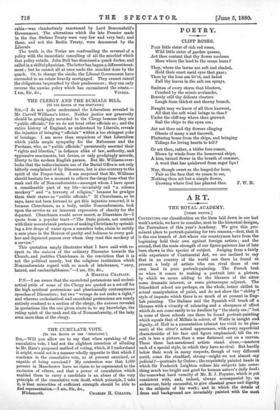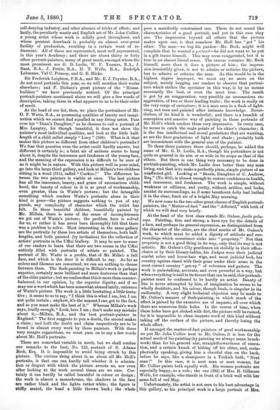ART.
[THIRD NOTICE.]
CONTINNING our classification on the lines laid down in our last. week's article, we have to consider, next to the historical designs,. the Portraiture of this year's Academy. We give this pro- minent place to portrait-painting for two reasons,—first, that it is the one branch of Art where our countrymen have from the- beginning held their own against foreign artists ; and the second, that the main strength of our figure-painters has of late- been shown in this species of subject. Judging from a fairly wide experience of Continental Art, we are inclined to say that in no country of the world can there be found at present a body of artists who can rival those of our own land in pure portrait-painting. The French beat us when it comes to making a portrait into a picture, by which we mean adding to the likeness of the sitter- some dramatic interest, or some picturesque adjunct. The Dusseldorf school are perhaps, on the whole, better skilled in actual manipulation of paint, and do not show the " slobby ":" style of impasto which there is so much of at present in Eng. lish painting. The Italians and the Spanish will touch off a likeness with a vivacity of colouring and a sharpness of effect which do not come easily to us dwellers by "the steely sea ;" but. in none of these schools can there be found portrait-painting. which equals that of Millais in colour, of Watts in insight aucl. dignity, of Roll in a presentation (almost too vivid to be plea- sant) of the sitter's actual appearance, with every superficial characteristic of his face and figure emphasised, till the re- sult is less a picture, than a man flattened out on a canvas. These three last-mentioned artists stand alone,—masters each of a special style, in which they have no rival. But hardly below their work in many respects, though of very different merit, come the steadfast, strong—might we not almost say judicial ?—portraits by Ouless ; the exquisitely painted heads in which Sir Frederick Leighton refines his subjects into some- thing much too bright and good for human nature's daily food; the somewhat hard veracity of Mr. E. J. Poynter, which is yet consistent with, and, indeed, always accompanied by, an endeavour, fairly successful, to give classical grace and dignity to the subjects of his work ; and in which the details of dress and background are invariably painted with the most self-denying industry, and utter absence of tricks of effect; and lastly, the peculiarly manly and English art of Mr. John Collier, a young artist whose work is solidly good throughout, and whose greatest drawback is probably an almost over-great facility of production, resulting in a certain want of re- finement. All of these are represented, most well xepresented, in this year's Academy; and there are about thirty or forty other portrait-painters, many of great merit, amongst whom the most prominent are G. D. Leslie, W. F. Yearnes, R.A., J. Sant, RA., J. Pettie, RA., H. T. Wells, ILA., Rudolph Lehmann, Val C. Prin,sep, and G. E. Hicks.
Sir Frederick Leighton, P.R.A., and Mr. E. J. Poynter, R.A., do not send portraits this year, so we will mention their works elsewhere; and F. Dicksee's great picture of the " House- builders " we have previously noticed. Of the principal portrait-painters mentioned above we will give a few words of description, taking them in what appears to us to be their order of merit.
At the head of our list, then, we place the portraiture of Mr. G. F. Watts, R.A., as possessing qualities of beauty and imagi- nation which we cannot find equalled in any living artist. Pass over his "Dean's Daughter," as he chooses to call a portrait of Mrs. Langtry, for though beautiful, it does not show the painter's most individual qualities, and look at the little half- length of a child called simply " Lucy " (188). What is it that makes this picture so different from other children's portraits P We fear that question even the artist could hardly answer, but different it certainly is; a faint air of sadness seems to hang about it, despite the innocence and freshness of the young face, and the meaning of the expression is as difficult to be sure of as it might be in nature. With this picture well in your mind, go into the large third gallery, and look at Millais's two children sitting in a wood. (315), called " Cuckoo!" The difference be- tween the two painters is visible at once. The last picture has all the innocence, beauty, and grace of unconscious child- hood, the beauty of colour in it is as great of workmanship, even greater, than in Watts's picture; but the intangible something which renders Watts's portraits alone in their kind is gone—the picture suggests nothing to you of any puzzle, any complexity of character which the artist has felt. In these beautiful children, beautifully painted by Kr. Millais, there is none of the sense of incompleteness we get out of Watts's picture ; the problem here is solved for us, or rather it has never been thoroughly felt that there was a problem to solve. Most interesting in the same gallery are the portraits by these two artists of themselves, both half- lengths, and both painted (by invitation) for the collection of artists' portraits in the Uffizi Gallery. It may be new to some of our readers to learn that there are two rooms in the 17ffizi entirely filled with portraits of artists so painted. The portrait of Mr. Watts is a profile, that of Mr. Millai^ a full face, and which is the finer it is difficult to say. As far as colour and likeness are concerned, we can see nothing to choose between them. The flesh-painting in Millais's work is perhaps superior, certainly more brilliant and more dexterous than that .of the elder painter; but we confess that this is more than counter- balanced, in our opinion, by the superior dignity, and if we may use a word which has been somewhat abused lately, reticence .of Watts's picture. The work is a little hesitating, a little tenta- tive; it seems to us to say, "I think this is what I am, but I am not quite certain ; anyhow, it's the nearest I can get to the fact, and so you must make the best of it." Whereas Millais's work says, loudly enough," Look, here I am ; don't make any mistake about it,—Millais, R.A., and the best portrait-painter in England." The first suggests to you a doubt, the second makes a claim ; and both the doubt and claim respectively are to be found in almost every work by these painters. With these very meagre suggestions, we must pass on to say a few words about Mr. Boll's portraits.
These are somewhat variable in merit, but we shall confine our remarks to the best, No. 123, portrait of S. Adams Beck, Esq. It is impossible to avoid being struck by this picture. The curious thing about it, as about all Mr. Boll's portraits, is that one can hardly tell whether it is admira- tion or disgust with which the picture arrests us, nor even after looking at the work several times are we sure. Cer- tainly it can hardly be called beautiful in colour or design ; the work is almost a monochrome, the shadows in the face are rather black and the lights rather white ; the figure is Stiffly seated, the head. a little thrown back ; the whole pose a manifestly constrained one. These do not sound like characteristics of a good portrait, and yet in this case they are. The impression beyond all others that the picture makes upon one, is that somehow Mr. Holl has " got " his sitter. The man—we beg his pardon—Mr. Beck, might well complain that he wanted a portrait—he did not want to be put in a gilt frame himself. This may seem exaggerated, but it is true in an almost literal sense. The canvas contains Mr. Beck himself, more than it does a picture of him ; the impres- sion irresistibly given, is not to admire or criticise the picture, but to admire or criticise the man. As this would be in the highest degree improper, we must say no more on the subject, merely begging our readers to observe that portrai- ture which strikes the spectator in this way, is by no means necessarily the best, or even the most true. The result is got by an exaggeration, very possibly an unconscious ex- aggeration, of two or three leading traits ; the work is really on the very verge of caricature ; it is a man seen in a flash of light- ning, not seen and painted after intimate knowledge. Never- theless, of its kind it is wonderful; and there is a breadth of conception and massive way of painting in these portraits of Mr. Boll's which renders them very impressive. In every case, he seems to catch the main points of his sitter's character; it is the fine intellectual and moral gradations that are wanting, as are the finer gradations of light and shade ; probably both are inconsistent with the general aim of the painter.
To these three painters there should, perhaps, be added the name of Mr. G. D. Leslie, R.A., though his portraiture is not quite so general in its aim or so wide in its scope as that of the others. But there is one thing very necessary to be done in portrait-painting, which Mr. Leslie does better than any man living, and that is to make a perfectly plain, simple picture of au unaffected girl. Looking at "Bessie, Daughter of C. Andrew, Esq." (No. 606), is almost enough to restore confidence in health, and innocence, and freshness. The work is simple, without weakness or silliness, and pretty, without artifice, and looks, amidst its surroundings, as if some beneficent deity had bathed it in the clear, fresh air of a bright May morning.
We now come to the two other great classes of English portrait- painters, the " Matter-of-fact " and the "Affected," with both of which we will deal very briefly.
At the head of the first class stands Mr. Ottless, facile prin. ceps. Painting, firm and strong, a keen eye for the details of a face, and perhaps its general expression, as distinguished from the character of the sitter, are the chief merits of Mr. Ouless's work, to which must be added a dignity of attitude and sur- roundings which sometimes sinks into "propriety." Not that propriety is not a good thing in its way, only that its way is not artistic. Mr. Ouless's City gentlemen sit stolidly in their office- chairs or by their library-tables, his Judges wear their judicial scarlet robes and horse-hair wigs, and most judicial look, his country squires stand with their guns under their arms in the most correct country " get-up " of velveteen and gaiters. The work is painstaking, accurate, and even powerful in a way, but when everything is said in its favour that can be said, this portrait- painter must be confessed to be hardly an artist. Beauty of line is never attempted by him, of imagination he seems to be wholly destitute, and his colour, though fresh, is singular in its uniformity. A very slight technical objection may be made to Mr. Ouless's manner of flesh-painting, in which much of the effect is gained by the excessive use of impost°, all over which there are numerous little holes. In the course of time, when these holes have got choked with dirt, the picture will be ruined, for it is impossible to clean impasto work of this kind without taking off the surface of the picture, and thereby losing the whole effect.
If amongst the matter-of-fact painters of good workmanship we put Mr. John Collier next to Mr. Ouless, it is less for the actual merit of his painting (by painting we always mean brush- work) than for his general aim, straightforwardness of execu- tion, and a certain knack of hitting off his sitter, and, meta- phorically speaking, giving him a cheerful slap on the back, before he says, like a shampooer in a Turkish bath, "Next man 1" In this case, it is next man or next woman, for Mr. Collier paints both equally well. His women portraits we especially happy, as a rule; the one (382) of Mrs. H. Gillmore Webb, for example, who stands in front of a brick wall with her arms full of red May.
Unfortunately, the artist is not seen to his best advantage in this gallery, as his principal work is a large portrait of Mrs. Mortimer Collier and children,—a lady lying at full length on a sofa, with her hair elaborately spread all over the back thereof, and her children holding up long tresses to look through laugh- ingly. This is, if the truth must be told, a thoroughly artificial and somewhat vulgar portrait. The best work, however, of Mr. Collier is not to be found at the Academy, but at the Grosvenor Gallery, and is a portrait of the painter's wife, which is as pretty a picture, as it is a good likeness. We have spoken strongly of the bad-taste of Mr. Collier's large Academy picture, as this want of refinement is a very common error with young painters, and one which is very apt to grow apace like Eastern mustard-seed. If it were necessary to convince Mr. Collier of what might happen to him if he continued to tread in the same path, the simplest plan would be to lead him gently into the second room at this exhibition, and station him in front of a gigantic picture by Mr. J. Pettie, RA., entitled, "Mrs. Dominick Gregg and Children." So standing, the friendly critic might take the artist by the button-bole, and whisper to him the following words of warning :—" My dear fellow, in a year or two's time, when your fame is assured, your prices doubled, and your election to Academic honours nearly or quite accomplished, you will find that temptations to pander to the public bad- taste are very strong. You will find that people will praise alike your merits and your defects, understanding neither, till at last, if you give way, you may end by being able to paint, and yet by producing something like this. Then, for your sins, it will be hung upon the line ; and perhaps some wretched person, -who's not been successful, but who used to draw well, in your old student days, will come and stand in front of it, as you do now, in front of this, and will for once, pity, not envy yon." For indeed no warning against vulgarity would be so effec- tive as the unspoken one of this picture by Mr. Pettie. It would be unfair to Mrs. Gregg and her children to enter into a description of the picture, as its smirking affectation must be almost entirely due to the painter's bad-taste, as is the insistence upon the embroidered slipper of the lady, and the shoes, stockings, sashes, itc., of the children. The whole picture teems with self-consciousness and millinery, the poor little children especially being melancholy examples of how little child- like a child can be. We said at the beginning of our article that no other country possessed such a group of portrait-painters as Watts, Millais, and loll; it must, however, be confessed that in no other country in the world, a painter of Academic rank could produce such a work as this. The innate snobbishness of our countrymen, seems here concentrated within the limits of a ten- foot canvas, and the result is a warning which will, we hope, not be neglected.




































 Previous page
Previous page